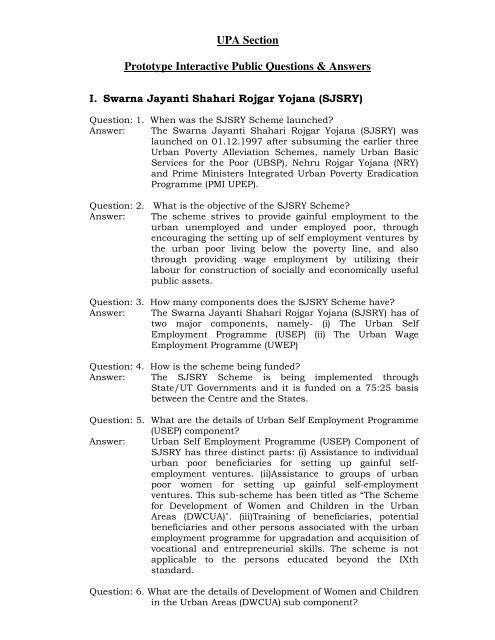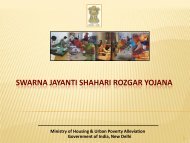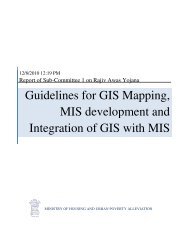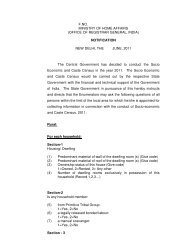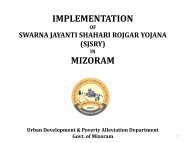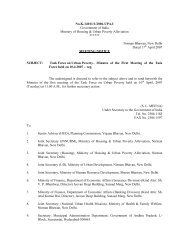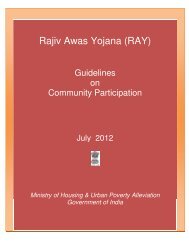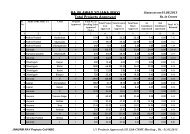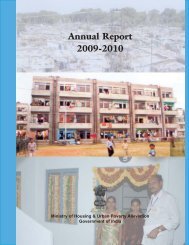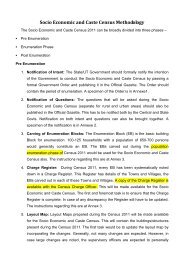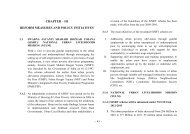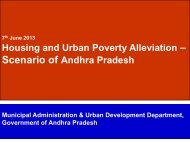UPA Section Prototype Interactive Public Questions & Answers
UPA Section Prototype Interactive Public Questions & Answers
UPA Section Prototype Interactive Public Questions & Answers
Create successful ePaper yourself
Turn your PDF publications into a flip-book with our unique Google optimized e-Paper software.
<strong>UPA</strong> <strong>Section</strong><strong>Prototype</strong> <strong>Interactive</strong> <strong>Public</strong> <strong>Questions</strong> & <strong>Answers</strong>I. Swarna Jayanti Shahari Rojgar Yojana (SJSRY)Question: 1. When was the SJSRY Scheme launched?Answer: The Swarna Jayanti Shahari Rojgar Yojana (SJSRY) waslaunched on 01.12.1997 after subsuming the earlier threeUrban Poverty Alleviation Schemes, namely Urban BasicServices for the Poor (UBSP), Nehru Rojgar Yojana (NRY)and Prime Ministers Integrated Urban Poverty EradicationProgramme (PMI UPEP).Question: 2. What is the objective of the SJSRY Scheme?Answer: The scheme strives to provide gainful employment to theurban unemployed and under employed poor, throughencouraging the setting up of self employment ventures bythe urban poor living below the poverty line, and alsothrough providing wage employment by utilizing theirlabour for construction of socially and economically usefulpublic assets.Question: 3. How many components does the SJSRY Scheme have?Answer: The Swarna Jayanti Shahari Rojgar Yojana (SJSRY) has oftwo major components, namely- (i) The Urban SelfEmployment Programme (USEP) (ii) The Urban WageEmployment Programme (UWEP)Question: 4. How is the scheme being funded?Answer: The SJSRY Scheme is being implemented throughState/UT Governments and it is funded on a 75:25 basisbetween the Centre and the States.Question: 5. What are the details of Urban Self Employment Programme(USEP) component?Answer: Urban Self Employment Programme (USEP) Component ofSJSRY has three distinct parts: (i) Assistance to individualurban poor beneficiaries for setting up gainful selfemploymentventures. (ii)Assistance to groups of urbanpoor women for setting up gainful self-employmentventures. This sub-scheme has been titled as “The Schemefor Development of Women and Children in the UrbanAreas (DWCUA)". (iii)Training of beneficiaries, potentialbeneficiaries and other persons associated with the urbanemployment programme for upgradation and acquisition ofvocational and entrepreneurial skills. The scheme is notapplicable to the persons educated beyond the IXthstandard.Question: 6. What are the details of Development of Women and Childrenin the Urban Areas (DWCUA) sub component?
Answer:-DWCUA aims at helping groups of urban poor women intaking up self -employment ventures. The group mayconsist of at least 10 women. The ceiling of subsidy underthe scheme is Rs. 1.25 lakh or 50% of the cost of theproject whichever is less.Question: 7. What are the details of Urban Wage EmploymentProgramme (UWEP) component?Answer: This component seeks to provide wage employment toprospective beneficiaries living below the poverty linewithin the jurisdiction of urban local bodies by utilizingtheir labour for construction of socially and economicallyuseful public assets. Under this component, there are norestrictions on educational qualifications. This programmeis implemented only in the urban local bodies havingpopulation less than 5 lakh as per the 1991 Census. Thematerial labour ratio for construction works under thiscomponent is to be maintained at 60:40. The prevailingminimum wage rate, as notified from time to time for eacharea, has to be paid to beneficiaries under this component.Question: 8. What is the role of Community organizations under thescheme?Answer: The successful implementation of the Swarna JayantiShahari Rozgar Yojana (SJSRY) relies on establishing andpromoting community organizations and structures toprovide supporting and facilitating mechanism for localdevelopment. Towards this end community organizationslike Neighbourhood Groups (NHGs), NeighbourhoodCommittees (NHCs) and Community Development Societies(CDSs) will be set up in the target areas. Financialassistance will be provided to these community structuresfor effective implementation of the programme and also fortheir social activities of community empowerment.Question:9. Is there any provisions for Information, Education andCommunication component under the scheme ?Answer: With a view to playing an effective role in coordination andin organizing training, monitoring, evaluation,dissemination of information etc. the component of IEC hasbeen evolved under SJSRY. It seeks to provide acoordinated and uniform level of training across thecountry for training of trainers, elected representatives,functionaries of Urban Local Bodies and field functionarieslike Project Officers, Community Organizers etc. throughNational Training Institutes and selected StateTraining/Field Training Institutes.Question: 10. What is the eligibility for setting up Micro–Enterprises(individual)?Answer: Annual family income should be less than Rs. 11850/- atthe 1991-92 prices, must be residing in the town for at
least three years and should not be a defaulter to anyNationalized Bank/Cooperative Bank.Question: 11. Is there any provision for setting up Thrift & Credit Society(T&CS)?Answer: Where the DWCUA group sets itself up as a Thrift & CreditSociety, in addition to its self employment ventures, it willbe eligible for an additional grant of Rs. 25,000 as revolvingfund at the rate of Rs. 1,000 maximum per member. Thefund is meant for purposes like purchases of raw materialsand marketing, infrastructure support, one time expenseon child care activity, expenses upto Rs. 500 on travel costof group members to bank, payment of insurance premiumfor self/spouse/child by maintaining savings for differentperiods by a member and any other expense allowed by theState in Group's interest. The revolving fund can beavailed by a Group only after one year of its formation.Question:12. What are the details of Skill Training?Answer: Appropriate training to the urban poor is a variety ofservices and manufacturing trades as well as in local skillsand local crafts is provided under the scheme. Trainingestimations by Govt., private or voluntary organizationsmay be utilized for this. Training cost of Rs. 2000/- perperson excluding material cost, trainer’s fees and misc.expenses would be provided. Training period would be twoto six months subject to a minimum of 300 hours. Tool Kitworth of Rs.600/- may also provided to the trainee whosatisfactory completed the training.Question: 13.What is the maximum limit of cost stipulated for setting upMicro Enterprises (individual)?Answer: The maximum unit cost will be Rs.50,000/- and themaximum allowable subsidy will be 15% of the project cost,subject to a limit of Rs.7,500/-.Question: 14.What are the details of Infrastructure Support?Answer: Special assistance may be provided for setting up ofcommunity seva kendras which could be used formultifarious activities such as work places/marketingcentres etc. for beneficiaries under this programme.Question:15. What is the role of Banks in implementing the SwarnaJayanti Shahari Rozgar Yojana (SJSRY)Answer: 95% of the Project Cost would be sanctioned as compositeloan (inclusive of subsidy) by bank at the rates of interestapplicable to such priority sector loans fixed by ReserveBank of India, from time to time. The loans would notrequire any collateral guarantee. Only assets created underthe programme would be hypothecated/mortgaged/pledgedto the bank advancing the loans. Repayment scheduleranges from 3 to 7 years after initial moratorium of 6 to 18months as decided by bank. The Community DevelopmentSociety (CDS)/Town Urban Poverty Eradication (UPE) Cells
will extend help to bank for ensuring repayment of loans asper rules.Question:16. What are the achievements of the scheme so far?Answer: Right from exception (1997-98) till now (As on 30.6.2008) atotal of Rs.163978.31 lakh has been released as centralshare. A total of 350.97 lakh persons benefited underCommunity Structure (CS). A total of 887020 personsbeneficiaries under Urban Self Employment Programme(USEP). A total of 298423 women benefited under DWCUA.1270637 persons has been imported Skill Training so far.Question:17. Is there any evaluation of the scheme made?Answer: The scheme was recently evaluated by as independentagency namely M/s Access Development Services, NewDelhi in 9 representative States/UTs (Tamil Nadu,Himachal Pradesh, Orissa, Gujarat, Assam, Kerala, Goa,Haryana and Delhi). On the basis of the recommendationsof the evaluation study as well as feedback from otherstakeholders, revamped of the Scheme of Swarna JayantiShahari Rozgar Yojana (SJSRY) is under way.Question:18. What are major recommendation of evaluating agency?Answer: Major recommendation of the evaluating agency are asfollow:-1. The scheme be counted is mission mode approach.2. Greater involvement of civil society/NGO.3. Qualitative aspects like increase in income, creation ofsocial and economic assets should also be focused.4. UWEP component scrapped or implemented as aseparate scheme.5. Focus should be given on Urban Self Employment.6. Creation of micro-enterprises be emphasis.A part from above sensitization of Government official,capacity building, rigorous identification of beneficiariesshould also be considered.


